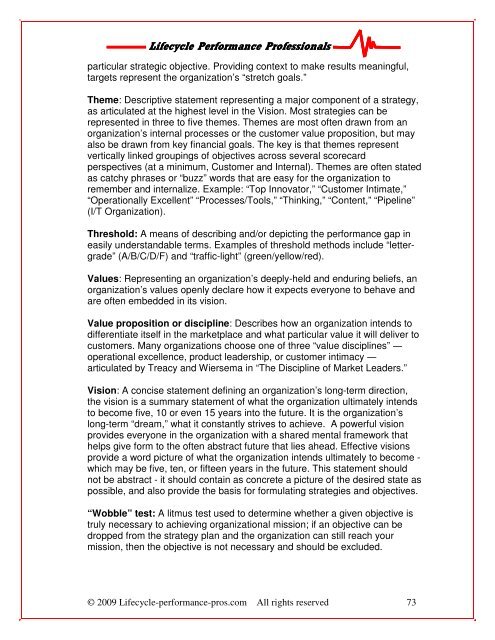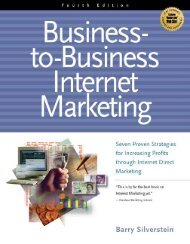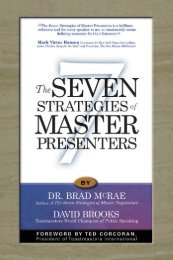Download the Performance Management Fundamentals Guide
Download the Performance Management Fundamentals Guide
Download the Performance Management Fundamentals Guide
You also want an ePaper? Increase the reach of your titles
YUMPU automatically turns print PDFs into web optimized ePapers that Google loves.
Lifecycle Lifecycle <strong>Performance</strong> <strong>Performance</strong> Professionals<br />
Professionals<br />
particular strategic objective. Providing context to make results meaningful,<br />
targets represent <strong>the</strong> organization’s “stretch goals.”<br />
Theme: Descriptive statement representing a major component of a strategy,<br />
as articulated at <strong>the</strong> highest level in <strong>the</strong> Vision. Most strategies can be<br />
represented in three to five <strong>the</strong>mes. Themes are most often drawn from an<br />
organization’s internal processes or <strong>the</strong> customer value proposition, but may<br />
also be drawn from key financial goals. The key is that <strong>the</strong>mes represent<br />
vertically linked groupings of objectives across several scorecard<br />
perspectives (at a minimum, Customer and Internal). Themes are often stated<br />
as catchy phrases or “buzz” words that are easy for <strong>the</strong> organization to<br />
remember and internalize. Example: “Top Innovator,” “Customer Intimate,”<br />
“Operationally Excellent” “Processes/Tools,” “Thinking,” “Content,” “Pipeline”<br />
(I/T Organization).<br />
Threshold: A means of describing and/or depicting <strong>the</strong> performance gap in<br />
easily understandable terms. Examples of threshold methods include “lettergrade”<br />
(A/B/C/D/F) and “traffic-light” (green/yellow/red).<br />
Values: Representing an organization’s deeply-held and enduring beliefs, an<br />
organization’s values openly declare how it expects everyone to behave and<br />
are often embedded in its vision.<br />
Value proposition or discipline: Describes how an organization intends to<br />
differentiate itself in <strong>the</strong> marketplace and what particular value it will deliver to<br />
customers. Many organizations choose one of three “value disciplines” ―<br />
operational excellence, product leadership, or customer intimacy ―<br />
articulated by Treacy and Wiersema in “The Discipline of Market Leaders.”<br />
Vision: A concise statement defining an organization’s long-term direction,<br />
<strong>the</strong> vision is a summary statement of what <strong>the</strong> organization ultimately intends<br />
to become five, 10 or even 15 years into <strong>the</strong> future. It is <strong>the</strong> organization’s<br />
long-term “dream,” what it constantly strives to achieve. A powerful vision<br />
provides everyone in <strong>the</strong> organization with a shared mental framework that<br />
helps give form to <strong>the</strong> often abstract future that lies ahead. Effective visions<br />
provide a word picture of what <strong>the</strong> organization intends ultimately to become -<br />
which may be five, ten, or fifteen years in <strong>the</strong> future. This statement should<br />
not be abstract - it should contain as concrete a picture of <strong>the</strong> desired state as<br />
possible, and also provide <strong>the</strong> basis for formulating strategies and objectives.<br />
“Wobble” test: A litmus test used to determine whe<strong>the</strong>r a given objective is<br />
truly necessary to achieving organizational mission; if an objective can be<br />
dropped from <strong>the</strong> strategy plan and <strong>the</strong> organization can still reach your<br />
mission, <strong>the</strong>n <strong>the</strong> objective is not necessary and should be excluded.<br />
© 2009 Lifecycle-performance-pros.com All rights reserved 73










